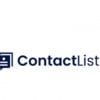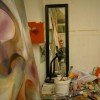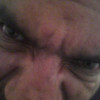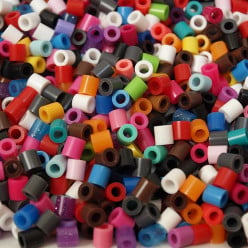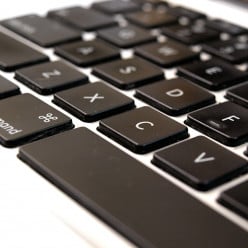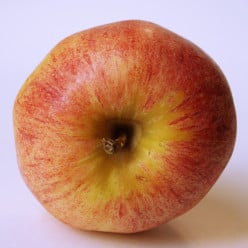How do you use tracing paper?
How do you use tracing paper?
I get how you trace the picture on to the tracing paper, but what's the best way of getting the traced picture back onto normal paper?I've always used an actual window, instead, as like a light box. Mind you, during the day of course. If the paper you want to transfer to isn't too thick for light to come through, then this will definitely work.
After tracing your image on to the tracing paper (preferably with a much darker pencil or marker that could be easily seen through the regular paper), tape it up onto the window. Then do the same with the paper you want to trace the image on to. Placing it over the tracing paper that has your traced image.
So the solid paper will be over the tracing paper with the traced image. Now that both are securely taped, overlapping one another on the window, be careful not to apply too much pressure against the window. You could risk cracking or breaking it. You should be able to see the traced image show through your regular paper now. Then you just go from here. Just like retracing. Only less mess with graphite shavings and powder.Thank you melovy I shall give that a try
I get how you trace the picture on to the tracing paper, but what's the best way of getting the traced picture back onto normal paper?
I get how you trace the picture on to the tracing paper, but what's the best way of getting the traced picture back onto normal paper?
There are 2 ways to do it:
First way:
1) Use a soft pencil (B or 2B or softer) to scribble on the back of the tracing paper along the lines of the tracing. You don’t need to be exact, just make sure you’ve covered the lines.
2) Then lay the tracing paper on your normal paper, right side up and go carefully over the lines of your tracing. This is the easiest way and is fine for most things, especially if you are going to paint over it.
Second way:
1) The other way you again use a soft pencil to go over the wrong side of the tracing but you carefully trace along the lines you’ve drawn. Then follow step 2 above.
This way avoids smudges on the final paper, so is best for detailed work.information is very useful hopefully can increase knowledge and become a source of reference for others
furniture klasik
furniture klasik modern
furniture klasik jepara
furniture klasik eropa
furniture klasik mewah
furniture klasik minimalisI believe they still make carbon paper. Lay it under the trace and trace the tracing. It'll make a nice dark line.
Invest in some carbon paper. Carbon paper is basically just what it sounds like; instead of having to scribble on the back, carbon is already in place. You simply lay it carbon side down on your new piece of paper, place your original image on top, and draw over it. You eliminate a step doing this.
If you're doing a lot of tracing and transferring, you may also want to look into buying a Tracer projector. Cheaper ones are basically a box with a lightbulb and a mirror that sit on top of your image and project it onto the wall. It'll set you back about $70. One of those will allow you to enlarge your piece much more simply than manually with tracing paper.
Hope that helps!Thank you for your additional tips as well KatMannel, carbon paper sounds like it might help me a lot.
I guess you wouldn't need tracing paper.
Use a light box. Its quite simply an aluminum box with a piece of frosted plexiglass and a few neon or fluorescent tube lights inside.
Yeah you're right. Just trace the picture onto tracing paper. Then to get that traced picture back to normal paper, sit at a table where there's enough sunlight, put a sheet of paper on top of the traced paper, can you see the outline of the picture you traced though the normal paper? Make sure you trace the picture in a dark colour. If you can see the ouline of the traced picture through the normal paper, then draw it.
There's another way. Trace the picture on tracing paper. Once you've done that, keep the tracing paper on top of a normal sheet of paper and draw tightly once again on the tracing paper so that the mark stays on the normal paper which is under the tracing paper. Take out the tracing paper and hold the normal paper to the sunlight. You will see the tightly drawn outline.
Hope this helps.Hello, this is Ravi RaJ. I Wants to Sale duplex in Ayodhya bypasses in Bhopal nearest Bhopal. That is Sale Duplex in Bhopal 2 BHK duplex there are 2 bathroom, 2 bedroom, self parking Area, park and many more facilities hares. This is a first hand pro
This is what I do when I can't lightbox something -- for instance when transferring to illustration board or canvas board. This is similar to scribbling on the back with a soft pencil but it gives a better coat -- once you have the drawing as you like it on the tracing paper, sprinkle graphite powder on the back and give it a good rub, blow off the excess and lay the tracing paper over the board, then trace your piece. You can purchase graphite powder at most art supply stores, but as I use lead holders to draw (I don't like shrinking pencils) every time I sharpen a lead I make powder. This is also good if you use non-photo blue leads -- it winds up being cleaner than regular graphite.
trace it as the original. Flip it over, blacked the lines and then flip back over the front, draw the lines again as the original and you get the perfect drawing
just lay it on what you're tracing and gently trace what you're gonna trace
Tracing paper is one of the most essential items in an artist's resource kit. Its transparent properties make it the ideal paper for copying images by hand in an exact and detailed manner. Students use tracing paper for various school projects and report covers and even crafts and art, as it helps them score well. It improves deftness and acts as an excellent cover for many reports. People can use tracing paper in a variety of ways, including basic tracing, for crafts and as a teaching tool. But also it can be used for tracing and transferring to other types of paper. Place almost any image below a sheet of tracing paper and use tracing and transferring methods. This method is used to turn the image into a drawing on another sheet of paper. Use a number two pencil to trace the image precisely and accurately. Once the image and all its detail are traced on the paper, turn the sheet over. Create rubbing marks using the side of the pencil point or even black charcoal crayon. Mostly People use a black charcoal crayon to create the rubbing marks on the back of the tracing paper. Once the entire flip side of the image is coated with pencil or crayon markings, turn the paper back to the image side. Place the tracing paper on top of a piece of drawing or construction paper and proceed to transfer the image. Using a fine or ballpoint pen, trace over each detail of the image and a pencil copy should show on the other paper. Use wax free tracing paper so that it doesn’t damages the fabrics it may come in touch with.
Use a number two pencil to trace the image precisely. Once the image and all its detail are on the paper, turn the sheet over and create rubbing marks using the side of the pencil point. People can also use a black charcoal crayon to create the rubbing marks on the back of the tracing paper.
If you don't have a light box you can try sticking your picture and piece of paper onto a window with good light behind it. Then trace. Works quite well in a pinch.
Related Discussions
- 17
Do you think it's disingenuous to trace images used in drawings and paintings?
by Dbro 6 years ago
Do you think it's disingenuous to trace images used in drawings and paintings?Many people posting art instruction type hubs will direct the reader to trace an image to be used in a certain art project or painting. I've always wondered if this wasn't a bit fraudulent. Shouldn't the artist draw...
- 4
DIY Wedding Invitations
by Noodles Australia 13 years ago
DIY INVITATIONSI recently got married and I did all the invitations myself! All I did was pick a photo that I liked that I could write text over. I personally chose Heart Reef which is in the Whitsundays, Queensland, Australia. My husband and I met in the Whitsundays, so this image was quite...
- 23
Does this image prove - beyond all doubt - that God does not exist and that the
by peterxdunn 10 years ago
Does this image prove - beyond all doubt - that God does not exist and that the Bible story...cannot be true?Look very carefully at this picture. It was taken by the Hubble Space Telescope (a true miracle of the modern age). The light from some of the galaxies shown here has been travelling through...
- 6
What is the marking material used in a "lead" pencil?
by Iznogoud 11 years ago
What is the marking material used in a "lead" pencil?
- 35
Boehner is asking for "a blank sheet of paper"
by fishskinfreak2008 14 years ago
Not gonna happen
- 5
Why is writing done in ink more permanent than writing done in pencil?
by Bits-n-Pieces 11 years ago
Why is writing done in ink more permanent than writing done in pencil?




